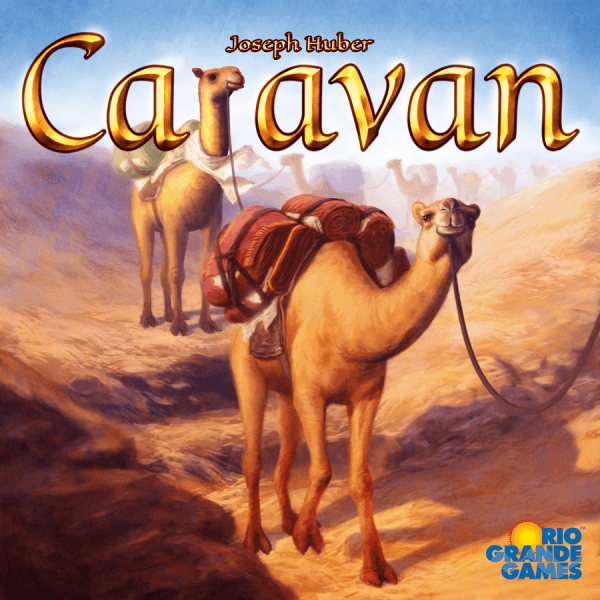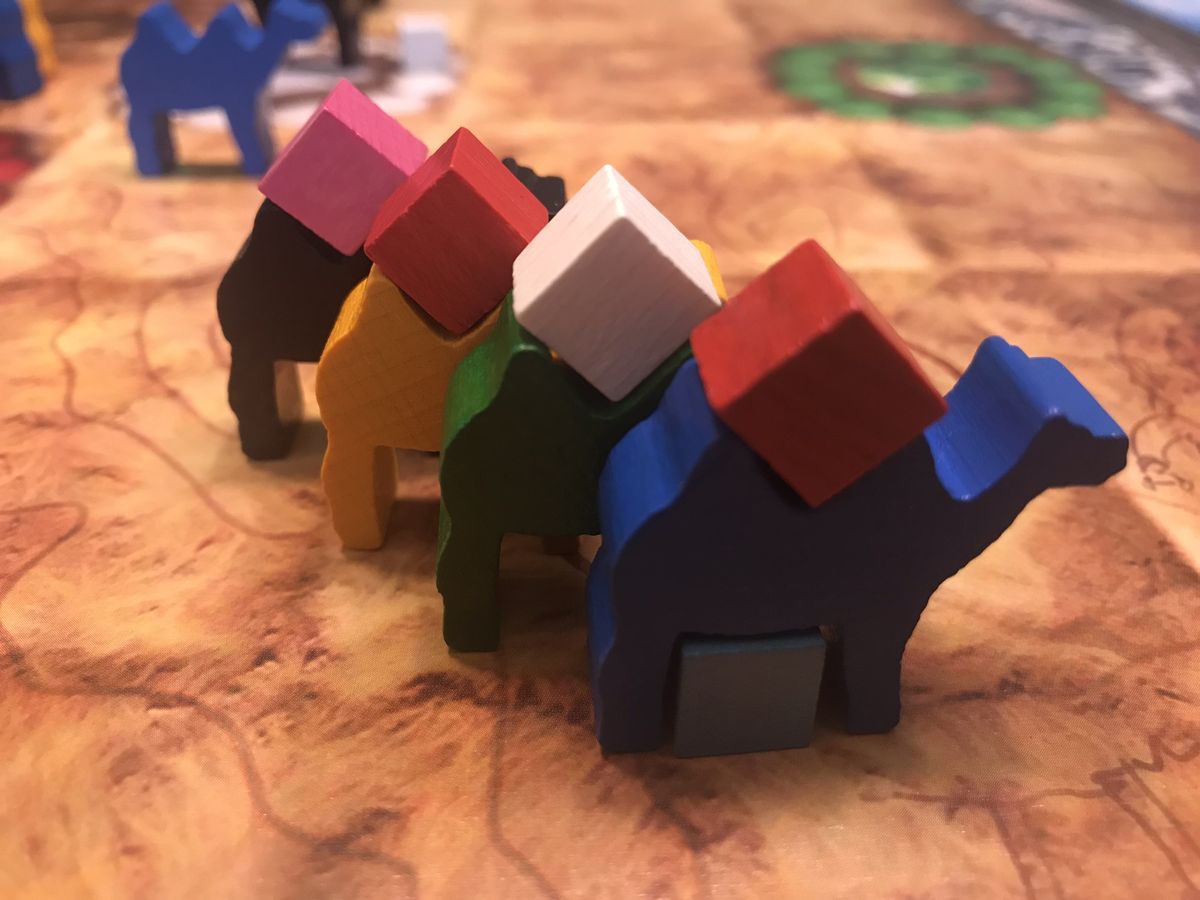Load and Ship Goods in West Africa by Camel in Caravan

Create and manipulate trade routes to transport the best goods across 14th Century West Africa as efficiently as possible.
Gameplay
Caravan is a 2-4 player game in which players are trying to construct caravans of camels to pick up and deliver goods across 14th Century West Africa. Each of the eight goods is represented by a uniquely colored cube. Goods are also broken out into four rare goods worth six points each per delivery and common goods worth three points each per delivery. The board contains corresponding cities matching the color of each good, which will be the destinations for players to deliver to.
Play begins with players seeding spaces numbered 1 through 8 with goods drawn at random from a bag. Depending on player count, a certain number of goods may be removed before the start of the game. Squares 1, 2, 7, and 8 — located at the far corners of the board — will also begin with demand markers. When goods are picked up from these spaces, players will also take the demand marker. In future turns, once four goods on any squares have been picked up, play pauses for four new goods to be drawn and demand markers to be placed on squares where goods have yet to be picked up.
The goal of the game is to deliver these goods to the corresponding cities on the board. The first player receives one action at the start of the game, and can place the first of their five camels on any space (in an introductory game or for a more casual experience, players may use six camels). The second player is allowed two actions, perhaps choosing to place two camels or perhaps to place one camel on a space with a good and then picking it up. Actions escalate until all players are able to complete four actions per turn (for example, in a four player game, the fourth player would receive four actions and from then on out, all players would receive four actions per turn).
To deliver goods, players will want to create caravans of adjacently placed camels and move picked up goods along this line. Actions that can be taken and their costs vary. Placing a camel on an empty space, picking up a good and placing it on a camel’s back, and moving a good from one camelback to the next in line are worth one action each. Placing a camel in an occupied space costs two actions. Players are also permitted to steal when sharing a space with an opponent camel that possess a good. This costs one action as well as a theft token given. All players begin with one theft token at the start of the game. If a player does not have any theft tokens, they may not steal a good. After a good is stolen, it is placed under a camel so that it may not be directly taken back from the other player. The theft token is given to the player whose good was stolen. Once a good is delivered along the caravan to the city of the same color, it is taken off the board and placed into each player’s individual stash.
Game play continues until only four goods remain on the board after the bag has been emptied. Once this occurs, the next delivery of a good to its corresponding city ends the game. Points from delivered goods as well as demand markers are calculated and the person with the most points is declared the winner.

Review
Despite its simple mechanics, Caravan offers a fun (if light) puzzle experience along with its pick up and delivery mechanism. How players place camels on the board, how they move goods, and how those goods are delivered to the corresponding cities is a study in optimization. In a two-player game, it’s fairly easy to stake a portion of the board and create an engine where few camels need to ever move, squares are rarely occupied by the other player, and stealing is minimal or a non-factor. However, optimization is harder to achieve because of the arbitrary nature of goods being drawn out of the bag. Also, spaces that begin to accumulate demand markers may be worth the journey even if the space only houses a common good. In larger player counts, many actions will be spent placing camels on shared spaces and thieving, adding a bit of take-that to the puzzle. The punishment for avoiding the fray may be worse than losing a good along the camel trail here or there.
This is also true for goods that may languish out on the far corners. The use of demand tokens to lure players away from their established routes is tempting enough, especially in tight contests, to test even the most patient of engines. If a player does not get out of their comfort zones, they may find themselves on the wrong side of the final results.
A drawback for some may be the art style. As one would expect in depicting the Western African deserts of the 14th Century, the board is largely shades of yellow and brown. Artist Martin Hoffmann does his best to dress it up with peppers, spices, and a feather on the margins of the board, as well as fantastically drawn features within the simulated sand. Coupled with the colorful camels and goods, these items pop off the board and play well with the theme.
Due to Caravan’s light weight and variations in gameplay, it has the ability to be taught to and played well by children as young as 6 and 7 despite the age suggestion of 12. The take-that elements may be a turn off for friendly players, but in lower play counts it is a non-factor and most casual players will be too busy optimizing their caravans to care much about thieving a good. This is evident by the presence of theft tokens, so if one player does take someone’s good and no one else attempts to steal from them, they will be left with no theft tokens and therefore unable to steal in subsequent turns.
This is what makes Caravan a success despite its simple trappings. Designer Joe Huber planned for nearly every play group and situation, with concessions for most playing circumstances and styles in a game that already has more depth than meets the eye.
Pros: Great for families or strategic cutthroats, clever combination of engine-building puzzle and pick up and delivery
Cons: Art and graphics may be perceived as drab, take-that can be minimized or maximized to the discontent of other players




